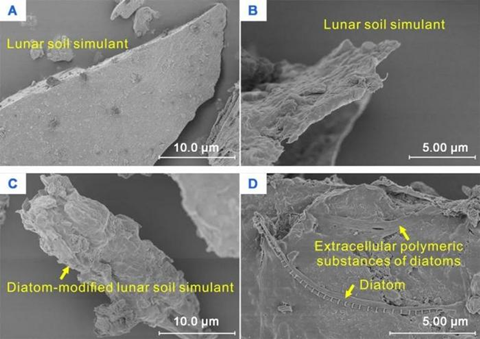Lunar soil, starkly different from Earth’s, lacks the essential nutrients and moisture critical for plant growth, rendering traditional agricultural models unfeasible on the Moon.

To address this challenge, a team led by Professor Yuxin Zhang and Dong Liu has proposed an innovative solution: leveraging diatoms to enhance lunar soil and enable sustainable lunar agriculture. The article is published in Biogeotechnics.
Diatoms, a type of photosynthetic algae, exhibit remarkable mineral weathering capabilities. Through biological weathering, they decompose minerals like olivine in lunar soil, releasing vital nutrients such as silicon, phosphorus, and calcium, which are indispensable for plant development (Figure 1).

Experimental results demonstrate that diatoms not only improve the water retention and aeration of lunar soil but also stimulate root growth, significantly enhancing the germination rate and growth speed of rice crops (Figure 2).
Resilience in space
Diatoms have been demonstrated to exhibit extraordinary resilience in space environments, thriving under extreme conditions such as low gravity, frigid temperatures, and intense radiation. Through photosynthesis, they efficiently absorb carbon dioxide and release oxygen, offering critical resources for the life support systems of lunar bases.

Additionally, the research team discovered that utilizing astronauts’ waste as a nutrient source for diatoms can significantly enhance their growth. This innovative approach not only facilitates waste recycling but also ensures the sustainable development of lunar agriculture, marking a pivotal step toward long-term lunar habitation.
This research establishes a groundbreaking technological pathway toward achieving self-sufficiency for lunar bases, while also laying a solid foundation for future space settlement and exploration.
READ MORE: Bacteria deployed to fix cracks in space bricks
READ MORE: Towards space plastics - and solving a few Earth problems en route
Diatoms hold immense potential to revolutionize space agriculture, offering a transformative solution for sustainable extraterrestrial ecosystems. Their integration into extraterrestrial ecosystems could play a pivotal role in enabling humanity to establish sustainable living environments not only on the Moon but also on other planets, marking a significant leap in our quest for deep-space habitation.







No comments yet